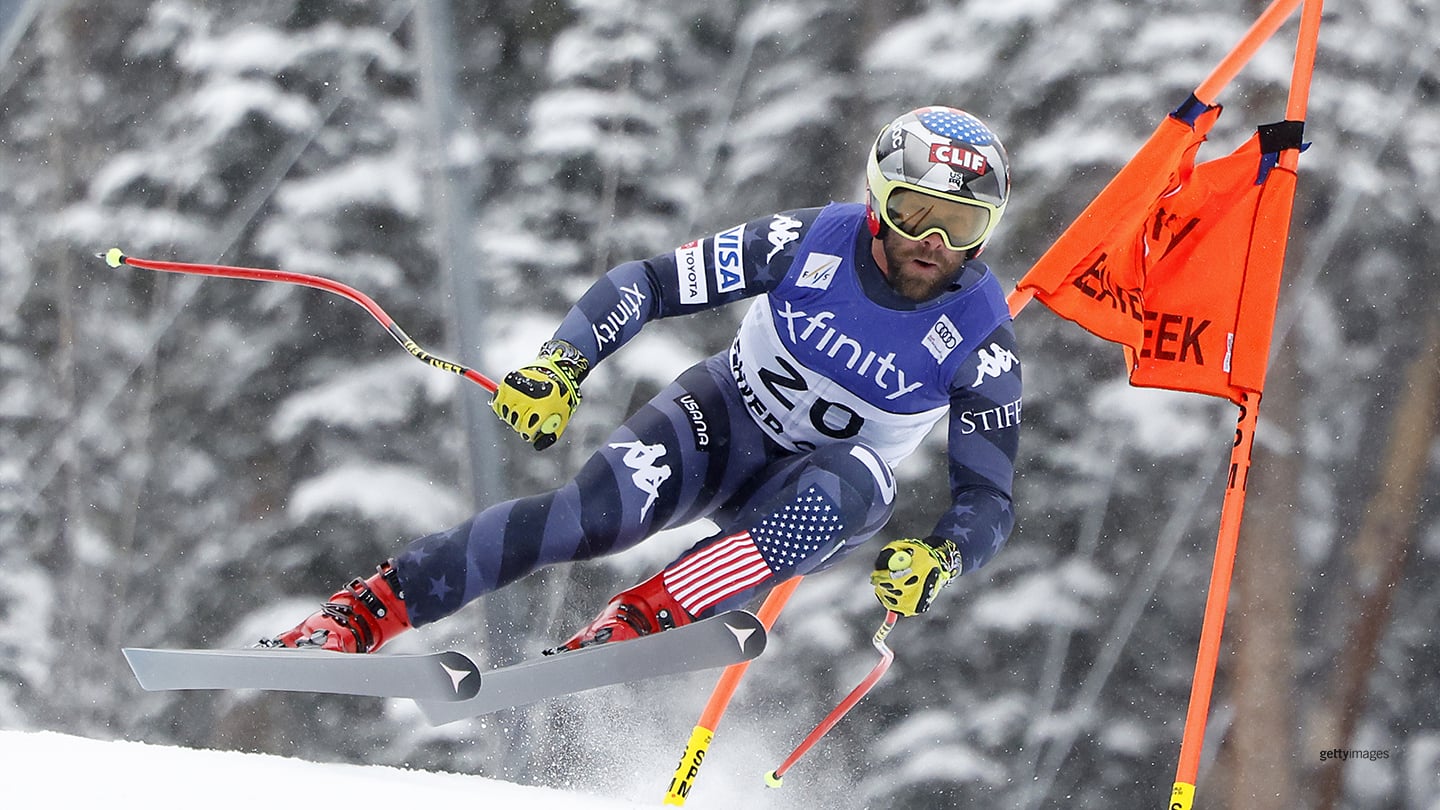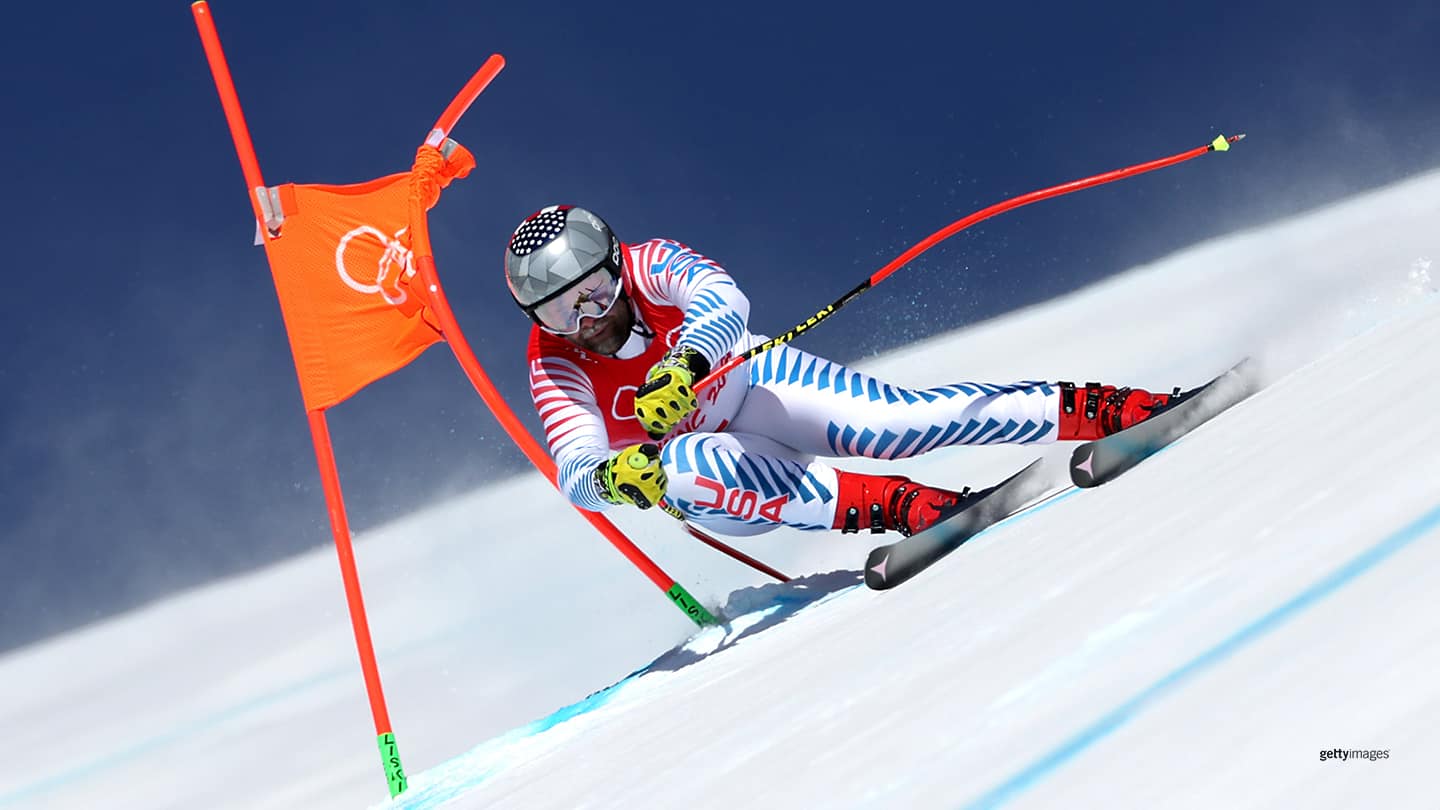
What Travis Ganong Plans For Retirement After His 18-Year Ski Career
by Peggy Shinn

Travis Ganong competes during the men's downhill at the 2022 FIS Alpine Ski World Cup on Dec. 3, 2022 in Beaver Creek, Colo.
On March 15, 2023, Travis Ganong will do his final run in men’s FIS World Cup downhill. The next day, the 34-year-old alpine skier plans to bid a adieu at the world cup finals in Andorra, along with his fiancée Marie-Michèle Gagnon, a Canadian slalom-turned-downhill skier.
“Marie-Michèle is also retiring this year, so in Andorra, we're going to do our last run together,” said Ganong as he sat on a delayed flight from California back to Europe for world cup finals. “Actually, we're doing a ceremonial retirement run together in the super-G. It's going be really fun.”
Earlier this month, Ganong’s longtime teammate, Steven Nyman, made a similar retirement run at the world cup in Aspen, skiing his final downhill in the famed American Downhillers faded denim vest. For the past decade, American downhill skiers have penned in their best finishes inside the vest, and Ganong and Nyman have led the charge, collecting 17 world cup podium finishes (and five wins) among them — the most of any American since Bode Miller and Daron Rahlves retired.
There is no idea what Gagnon will wear in her ceremonial ski run, although it won’t be a wedding dress – not yet. Too busy training and racing on their respective national teams (almost 18 years for Ganong, 17 years for Gagnon), the two have not had time to plan a wedding yet. Hopefully summer 2024, said Ganong. And eventually, they wish to start a family of their own.
One of only three American men to win a world championship medal in downhill in the 21st century (with a silver medal in 2015), Ganong is ending his career on a high note. In January 2023, he scored a bucket-list item: He finished on the podium in the famed Hahnenkamm downhill in Kitzbühel, Austria. The Hahnenkamm, held on the notorious Streif, is known as the most difficult downhill on the world cup tour. The “Startschuss,” a 51 percent grade, leads into the “Mausefalle,” an 85 percent incline (almost vertical). Then, at speeds approaching 75 mph, downhillers have to navigate a 180-degree turn, where centrifugal forces exceed 3 g’s. From there, it’s another leg-aching, minute-plus to the finish, with more jumps and difficult turns.
“I've won races, and I've performed to the Olympics,” said Ganong, a two-time Olympian who finished fifth in the downhill at the Olympic Winter Games Sochi 2014. “But this last year, I knew it was my last season, and I've always wanted to perform at Kitzbühel, so I knew it was my last chance this year. That was kind of my only focus.”
In the dozen years that Gangon has raced the Hahnenkamm, he has finished in podium position in a few training runs. But until this season, his best finish in a Kitzbühel downhill was seventh.
“Looking at my whole career, I always knew I had more opportunity ahead of me [in the Hahnenkamm],” he added. “But then this year, knowing it was my last, I was able to have an amazing performance at the toughest downhill, and that really made me happy and capped off an amazing career.”
So, why is he retiring?
After 18+ years focused solely on ski racing, Ganong has found his mind wandering lately. He grew up freeskiing in the big mountains around Lake Tahoe, chasing his older sisters (Megan was also on the U.S. Ski Team over a decade ago). But his outdoor life was not confined to winter.
“I lived an adventurous life outdoors, spending time on Lake Tahoe and mountain biking, climbing, running through the woods just exploring, that was literally my life,” he said.
While he loved ski racing, the focus and training required made him feel disconnected from an all-encompassing outdoor lifestyle.
“Lately, it was getting to the point where I was starting to be more curious about other things, other interests that I’ve put on hold for the past 18 years,” he said. “The last couple of years, it’s been difficult to really dedicate the same amount of effort to racing as I had in the past because I was getting really excited about future projects and endeavors.”

Travis Ganong competes during the men's downhill at the Olympic Winter Games Beijing 2022 on Feb. 4, 2022 in Yanqing, China.
Rather than let his ski-racing career peter out, he decided to retire while he was still healthy with a future in skiing. Just not ski racing.
Ganong is currently working out the details of what the future projects and endeavors will include. He hired a business partnerships manager to help with the transition. While he cannot yet give specifics, Ganong said his future will include partnerships with his longtime sponsors through film, podcasts, photo shoots and product development on the radar. He also wants to take clients on trips to the mountains where they all can “share these amazing moments together.”
Climate change is also on Ganong’s radar, and he wants to deepen his involvement with Protect Our Winters, a network of pro athletes and outdoor enthusiasts who are lobbying political leaders and industry to address climate change.
“Without snow, there’s no more skiing in the future, and that’s something that’s really near and dear to me as a professional skier,” he said.
During the Aspen world cup, Ganong participated in a climate change panel. It was the first of what he hopes will be many such opportunities.
Ganong has also addressed the outcome of climate change more directly. With unprecedented snowfall in the Sierras this winter — and a heavy, wet dump forecast as he was leaving for world cup finals (the same storm that was causing his flight delay) — the downhiller spent three days last week shoveling the roof of the house he shares with Gagnon in Tahoe City, California.
“I have carpel tunnel syndrome in my hands now,” he said. “But I got the snow removed so I can rest easy knowing that [the roof] won’t collapse while we’re gone.”
Not ideal training for a world-class athlete leading into his final race. But Ganong is excited about the future of the American downhillers, even if they will feel the loss of their veteran leaders. In Aspen, Ganong chose not to race the super-G so he could celebrate Nyman’s retirement.
“Our guys really stepped up in the super-G,” said Ganong, pointing out Erik Arvidsson’s 14th and Jared Goldberg’s 15th place finishes in that race. Ryan Cochran-Siegle and Bryce Bennett also scored top-30 finishes.
“I think they’re ready to fill the shoes and really push the next generation of downhillers,” Ganong said. “It’s going to be really fun to watch what they do coming up. They have the talent, they have the speed, and I think they’re going to figure it out.”